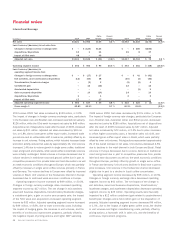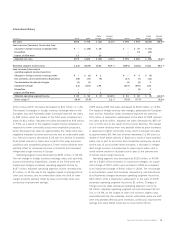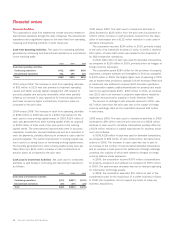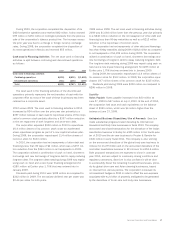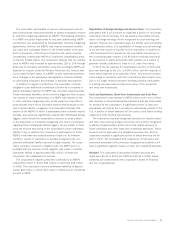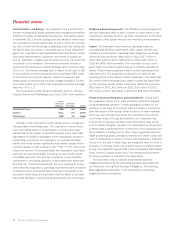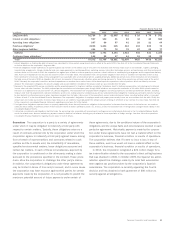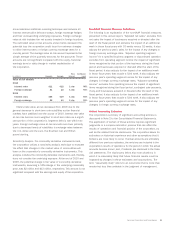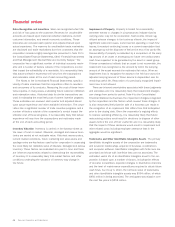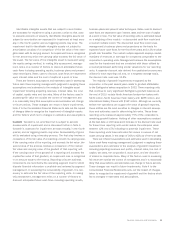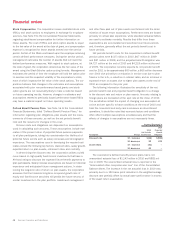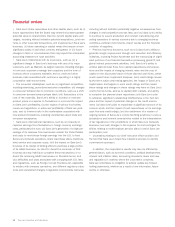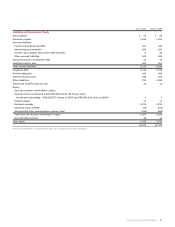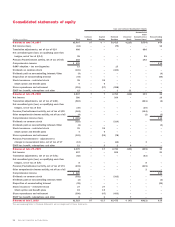Sara Lee 2010 Annual Report Download - page 46
Download and view the complete annual report
Please find page 46 of the 2010 Sara Lee annual report below. You can navigate through the pages in the report by either clicking on the pages listed below, or by using the keyword search tool below to find specific information within the annual report.Sales Recognition and Incentives Sales are recognized when title
and risk of loss pass to the customer. Reserves for uncollectible
accounts are based upon historical collection statistics, current
customer information, and overall economic conditions. These
estimates are reviewed each quarter and adjusted based upon
actual experience. The reserves for uncollectible trade receivables
are disclosed and trade receivables due from customers that the
corporation considers highly leveraged are presented in Note 15 to
the Consolidated Financial Statements, titled “Financial Instruments
and Risk Management Interest Rate and Currency Swaps.” The
corporation has a significant number of individual accounts receiv-
able and a number of factors outside of the corporation’s control
that impact the collectibility of a receivable. It is reasonably likely
that actual collection experience will vary from the assumptions
and estimates made at the end of each accounting period.
The Notes to the Consolidated Financial Statements specify a
variety of sales incentives that the corporation offers to resellers
and consumers of its products. Measuring the cost of these incen-
tives requires, in many cases, estimating future customer utilization
and redemption rates. Historical data for similar transactions are
used in estimating the most likely cost of current incentive programs.
These estimates are reviewed each quarter and adjusted based
upon actual experience and other available information. The corpo-
ration has a significant number of trade incentive programs and a
number of factors outside of the corporation’s control impact the
ultimate cost of these programs. It is reasonably likely that actual
experience will vary from the assumptions and estimates made
at the end of each accounting period.
Inventory Valuation Inventory is carried on the balance sheet at
the lower of cost or market. Obsolete, damaged and excess inven-
tories are carried at net realizable value. Historical recovery rates,
current market conditions, future marketing and sales plans and
spoilage rates are key factors used by the corporation in assessing
the most likely net realizable value of obsolete, damaged and excess
inventory. These factors are evaluated at a point in time and there
are inherent uncertainties related to determining the recoverability
of inventory. It is reasonably likely that market factors and other
conditions underlying the valuation of inventory may change in
the future.
Impairment of Property Property is tested for recoverability
whenever events or changes in circumstances indicate that its
carrying value may not be recoverable. Such events include sig -
nificant adverse changes in the business climate, the impact of
significant customer losses, current period operating or cash flow
losses, forecasted continuing losses or a current expectation that
an asset group will be disposed of before the end of its useful life.
Recoverability of property is evaluated by a comparison of the carry-
ing amount of an asset or asset group to future net undiscounted
cash flows expected to be generated by the asset or asset group.
If these comparisons indicate that an asset is not recoverable, the
impairment loss recognized is the amount by which the carrying
amount of the asset exceeds the estimated fair value. When an
impairment loss is recognized for assets to be held and used, the
adjusted carrying amount of those assets is depreciated over its
remaining useful life. Restoration of a previously recognized impair-
ment loss is not allowed.
There are inherent uncertainties associated with these judgments
and estimates and it is reasonably likely that impairment charges
can change from period to period. Note 4 to the Consolidated
Financial Statements discloses the impairment charges recognized
by the corporation and the factors which caused these charges. It
is also reasonably likely that the sale of a business can result in
the recognition of an impairment that differs from that anticipated
prior to the closing date. Given the corporation’s ongoing efforts
to improve operating efficiency, it is reasonably likely that future
restructuring actions could result in decisions to dispose of other
assets before the end of their useful life and it is reasonably likely
that the impact of these decisions would result in impairment and
other related costs including employee severance that in the
aggregate would be significant.
Trademarks and Other Identifiable Intangible Assets The primary
identifiable intangible assets of the corporation are trademarks
and customer relationships acquired in business combinations
and computer software. Identifiable intangibles with finite lives are
amortized and those with indefinite lives are not amortized. The
estimated useful life of an identifiable intangible asset to the cor-
poration is based upon a number of factors, including the effects
of demand, competition, expected changes in distribution channels
and the level of maintenance expenditures required to obtain future
cash flows. As of July 3, 2010, the net book value of trademarks
and other identifiable intangible assets was $504 million, of which
$450 million is being amortized. The anticipated amortization over
the next five years is $219 million.
44 Sara Lee Corporation and Subsidiaries
Financial review


